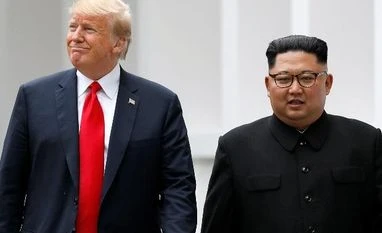When Donald Trump shook hands with Kim Jong Un in Singapore a year ago, US officials suggested North Korea was poised to give up its nuclear weapons. The president’s top diplomat even predicted disarmament would take about two years and said the US had “big teams ready to go.”
Those teams are still waiting.
A year after Singapore and a second, more confrontational meeting between Trump and Kim in Hanoi in February, the US and North Korea are stuck in the same spot -- still waiting to begin substantive talks on dismantling North Korea’s nuclear program in return for lifting sanctions that have cut off the isolated country’s economy from the world.
That’s forced US officials to confront the reality that Trump’s top-down approach has proven no better at achieving a breakthrough than the strategies deployed by previous administrations that he and his team have criticized so frequently.
Despite the president’s frequent praise of Kim -- this week he boasted that the dictator sent him a “beautiful letter” -- there’s still no evidence that North Korea has made a strategic decision to give up its nuclear weapons program, according to people familiar with the talks. Kim has stopped just short of Trump’s red line by continuing a moratorium on intercontinental ballistic missile firings and underground nuclear tests.
“We should be concerned that here we are a year after the Singapore summit and the fundamentals required to carry out a productive diplomatic process still are not in place,” said Suzanne DiMaggio, a senior fellow at the Carnegie Endowment. “The top-down approach was a bold move, but the formulation and execution of a coherent strategy beyond the summitry has been missing.”
North Korea has rebuffed most outreach efforts by Secretary of State Michael Pompeo, who had initially offered the two-year time frame, and his team. When the two sides have met, there’s been no sign that Kim’s emissaries were empowered to engage in working-level negotiations that would start down a path to disarmament, according to the people, who discussed the sensitive talks on condition of anonymity.
That was made clear at the second Trump-Kim summit in Vietnam, when North Korea calculated Trump was desperate for a deal. Instead, the American president walked away from an offer for North Korea to give up its Yongbyon nuclear site in exchange for relief from most sanctions.
Pompeo’s Claims
“In Hanoi, Kim showed he wasn’t willing to go any further than his father and his grandfather,” said Bruce Klingner, a senior research fellow for Northeast Asia at the Heritage Foundation in Washington. “I think it’s clear that Kim has not agreed to what Pompeo claims he agreed to.”
The US stance, at least publicly, has been that the administration won’t give any sanctions relief to North Korea until it gives up its nuclear arsenal and capabilities. But critics argue it’s simply untenable for the US to demand total capitulation from North Korea at the start of the process. They say Trump should have given Kim some initial reward for action instead of sending him home from Hanoi empty-handed.
“I’ve certainly advocated in that direction and I have heard that there may be more flexibility on that front,” DiMaggio said. “It’s unrealistic to expect Kim Jong Un to agree to an approach that provides no opportunities to address economic challenges early in the process.”
Trump’s Not ‘Disturbed’
For the time being, Trump and his aides believe they have North Korea where they want it. They contend that sanctions continue to bite, even if enforcement may have loosened, particularly along the border with China. And the president believes that as long as North Korea isn’t testing long-range, nuclear-capable missiles, the threat is vastly reduced.
US officials point to several successes: No Americans have been seized by North Korea in some time. And when the regime launched short-range ballistic missiles in May -- a move that his advisers eventually acknowledged violated UN Security Council resolutions -- Trump tweeted that it “disturbed some of my people, but not me.”
Trump says he’s defused an explosive situation through his one-on-one diplomacy.
“If I weren’t president you would be in a major war right now with North Korea,” he said Friday in an interview with Fox News. He said “I’m in no rush” because “they’re not testing nuclear.”
Yet the clock is ticking. In a statement carried by North Korea’s state news agency in April, Kim gave the US until the “end of the year” to have a change of heart.
‘No Hope’
Democratic Senator Chris Murphy, a member of the Foreign Relations Committee, said that the two Trump-Kim summits have made Kim "stronger than ever before."
“There’s virtually no hope of a third meeting doing anything but continuing to legitimize Kim’s brutal, brutal rule while giving him cover to continue his nuclear weapons program,” Murphy said.
Those close to the stalled negotiations are raising the possibility that after returning home embarrassed by the failed Hanoi summit, Kim’s regime may be ready to engage again. On Thursday, South Korean President Moon Jae-in said the letter from Kim that Trump called “beautiful” included an “interesting part” that hasn’t been disclosed.
“I was glad that we didn’t take a terrible deal in Hanoi just to take a deal, and maybe this is a good thing,” said Jung Pak, a senior fellow at the Brookings Institution. “The president himself saw that despite all of his commentary about how Kim is committed to denuclearization, he’s actually not committed and there’s a lot of work to do.”
©2019Bloomberg
Unlock 30+ premium stories daily hand-picked by our editors, across devices on browser and app.
Pick your 5 favourite companies, get a daily email with all news updates on them.
Full access to our intuitive epaper - clip, save, share articles from any device; newspaper archives from 2006.
Preferential invites to Business Standard events.
Curated newsletters on markets, personal finance, policy & politics, start-ups, technology, and more.
)